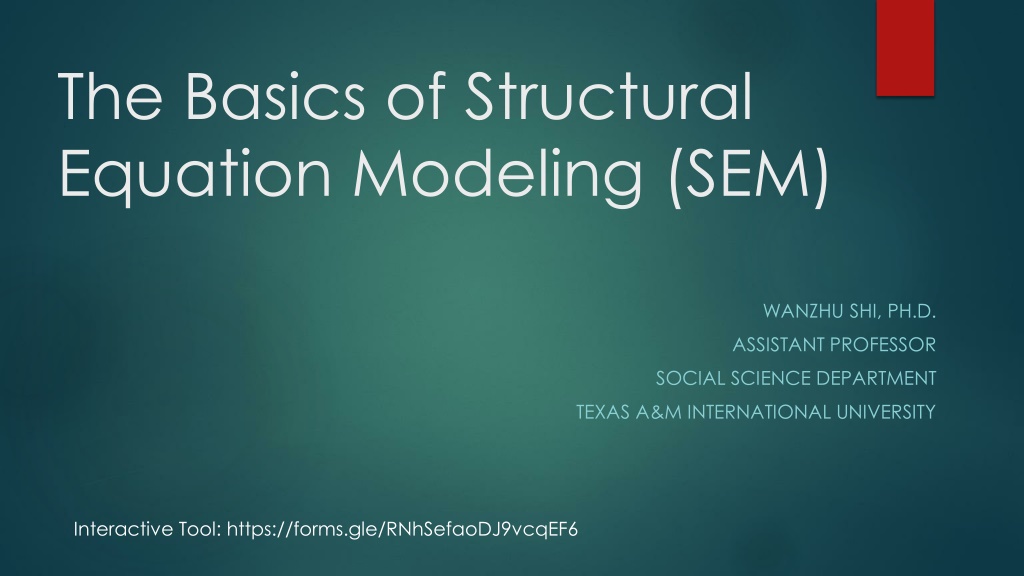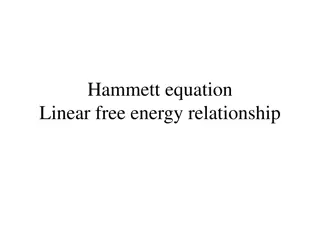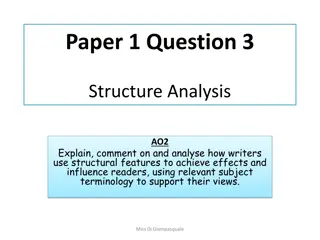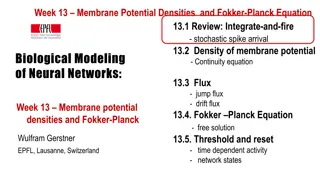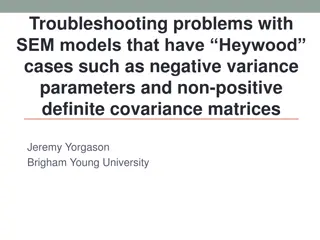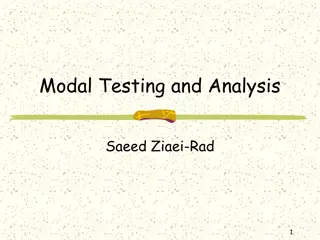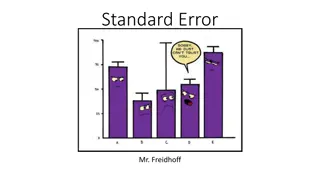Understanding Structural Equation Modeling (SEM) and Quality of Life Analysis
Structural Equation Modeling (SEM) is a statistical technique used to analyze relationships between variables, including quality of life factors such as physical health and mental well-being. Quality of life is a multidimensional concept encompassing various aspects like social relationships, living conditions, and environmental factors. This analysis involves regression equations for different variables and aims to evaluate complex models for goodness-of-fit. Latent constructs play a key role in understanding unobservable factors influencing measured variables. By employing SEM, researchers can gain insights into how different factors interrelate to impact overall quality of life, especially in challenging situations like the COVID-19 pandemic.
Download Presentation

Please find below an Image/Link to download the presentation.
The content on the website is provided AS IS for your information and personal use only. It may not be sold, licensed, or shared on other websites without obtaining consent from the author. Download presentation by click this link. If you encounter any issues during the download, it is possible that the publisher has removed the file from their server.
E N D
Presentation Transcript
The Basics of Structural Equation Modeling (SEM) WANZHU SHI, PH.D. ASSISTANT PROFESSOR SOCIAL SCIENCE DEPARTMENT TEXAS A&M INTERNATIONAL UNIVERSITY Interactive Tool: https://forms.gle/RNhSefaoDJ9vcqEF6
On March 27 2020, the city of Laredo issued a lockdown order due to the urgent spread of COVID-19. All non-essential businesses must close and unnecessary travel stop. No public gatherings of any size were allowed, and even travel by bicycle or foot travel was prohibited, unless it was essential activities Although the self-quarantine was necessary during that time, many people began to have psychological issues. Researchers begin to notice that the COVID-19 virus has influenced people s quality of life comprehensively.
What is quality of life? Multidimensional factors that include everything from physical health, psychological state, level of independence, family, education, wealth, religious beliefs, a sense of optimism, local services and transport, employment, social relationships, housing and the environment. (Barcaccia, 2013). How should we measure the quality of life? Mental Health Health Physical Health Green Space Natural and living environment Recreation Sources Quality of Life Work Material living conditions What indicators/factors would you use to reflect these construct variables? https://anima-project.eu/what-does-anima-do/quality-of-life- and-annoyance/qol-result-1/
Before SEM Multiple Regressions Quality of Life (Dependent variable) y1 = 1+ 1X1 + 2X2 + 3X3 Health (Dependent variable/Independent variable) y2 (X1) = 2+ 4X4 + 5X5+ 6X6 Mental health (D/Ind) y3 (X4) = 3+ 7X7 + 8X8+ 9X9 Physical Health (D/Ind) y4 (X5) = 4+ 10X10 + 11X11+ 12X12 Natural and living environment (D/Ind) y5 (X2) = 5+ 13X13 + 14X14+ 15X15 Each dependent variable has one regression equation; each time runs one regression model
Structural Equation Modeling Structural equation modeling is a multivariate statistical analysis technique that is used to analyze structural relationship. It is a combination of factor analysis and multiple regression analysis It is used to analyze the structural relationship between measured variables and latent constructs It can provide a summary evaluation for a complex model by checking the goodness-of-fit
What is a latent construct? Latent constructs are theoretical cannot be observed/measured directly The researcher must operationally define the latent variable of interest in terms of behavior believed to represent it. As such, the unobserved variable is linked to one that is observable, thereby making its measurement possible (Byrne, 2013, p.4). Researcher(s) usually need to develop a set of indicators, which can represent the underlying construct Issues with the latent construct Measurement validity Measurement reliability
What is your research question? What major are you in? Are there going to be any latent constructs in your research questions? How are you planning to measure all the variables related to your research questions? What is the level of measurements of your variables?
Basic Diagram Symbols in SEM Latent construct (Indirectly measurable) Indicator (directly measurable) Direct relationship A Simple latent variable model in SEM Covariance or correlation This model involves three equations: X1 = aL1 + e1 X2 = bL1 + e2 X3 = cL1+e3 e Measurement error
Key terms in SEM Endogenous variable (dependent): the resulting variables that are a causal relationship Exogenous variable (independent): the predictor variables Indicator: a measurable variable used to represent a latent construct. Path: the link between constructs, or from construct to indicators; often measured through a path coefficient Path diagram: shows the graphical representation of cause and effect relationships of the theory
Confirmatory Factor Analysis (CFA) Confirmatory factor analysis (CFA) is a multivariate statistical procedure that is used to test how well the measured variables represent the number of constructs. CFA is a tool that is used to confirm or reject the measurement theory It is suggested that for each latent construct, it needs at least three indicators to reflect
Measurement Model and Model Fit Index There are more than a dozen different fit statistics researchers use to assess the SEM models. Here is a list of the most popular fit statistics used and recommended thresholds, which indicate the model has a good fit. Measure Name Thresholds 2 Model Chi-Square P-value >0.05 GFI Goodness of Fit GFI 0.95 NFI Normed-Fit Index NFI 0.95 CFI Comparative Fit Index CFI 0.90 RMSEA Root mean Square Error of Approximation Root Mean Square Residual RMSEA < 0.08 RMR SRMR < 0.08 An example of SEM Measurement Model AVE Average Value Explained AVE > 0.5
Software for SEM AMOS (IBM SPSS) Friendly to beginners Have some limitations (won t handle well with categorical variables; have a limited capacity for multi-level modeling) Lavaan (R) Free M-plus CALIS (SAS) SEPATH (Statistica) LISREL
Example 1 Junior Facultys Work-Life Balance Research questions: How do junior faculty in public affairs programs manage their work-life balance? Do universities have adequate work-life balance policies in place for junior faculty? How do workload, stress, existence of supportive policies, and individual and institutional factors relate to faculty perceptions of work-life balance? Within academia, work-life balance incorporates the breakdown between different aspects of the workload, including teaching, research, services, and administrative responsibilities, as each of these roles contributes to the overall time spent on work (Curnalia & Mermer, 2018). Organizations have developed a number of initiatives to address work- life balance, including formal and informal policies (Beauregard & Henry, 2009.
Proposed Measurement Model Variables Measurement Indicator(s) Work-life balance (WLB) Overall satisfaction with your work-life balance How often do the demands of your job interfere with your personal/family/social life Have you faced any commonly reported challenges since you were hired as a junior faculty? Workload Time spent on: researching/teaching/services What is your teaching load? How many committees do you serve on? The use of work-life balance policies Please indicate the number of work-life balance policies being available to you in your institution Do you think your institution provide adequate work-life policies to you? Please rate your satisfaction level to the work-life balance policies at your institution Stress Have you faced the following stress since you were first hired as a junior faculty? Do you concerned what others think if you use work-life balance policies in your institution? How much do you feel the pressure of getting the tenure status?
Junior Faculty Work-Life Balance Full Model Fitness Index and Standardized coefficients and Standard Errors Measure Name Thresholds 2 Model Chi-Square P-value >0.05 GFI Goodness of Fit GFI 0.95 NFI Normed-Fit Index NFI 0.95 CFI Comparative Fit Index CFI 0.90 RMSEA Root mean Square Error of Approximation RMSEA < 0.08 RMR Root Mean Square Residual SRMR < 0.08 AVE Average Value Explained AVE > 0.5
Junior Facultys Work-Life Balance Results Faculty stress, workload, and work-life balance policies influence work-life balance Male faculty report less stress than female faculty Black faculty reported less stress than white faculty Faculty spend more time teaching and in administrative responsibilities and less time conducting research and fulfilling service obligations than what is on their contract
Thank you! Questions? Feedback on Google Form Contact Information: wanzhu.shi@tamiu.edu
Reference Azevedo, L., Shi, W., Medina, P. S., & Bagwell, M. T. (2020). Examining junior faculty work-life balance in public affairs programs in the United States, Journal of Public Affairs Education, DOI: 10.1080/15236803.2020.1788372 Byrne, B. M. (2013). Structural equation modeling with LISREL, PRELIS, and SIMPLIS: Basic concepts, applications, and programming. Psychology Press. Gefen, D., Straub, D. W., & Boudreau, M-C. (2000). Structural equation modeling and regression: Guidelines for research practice. Communications of the AIS, 4(7), 1-76. Statistics Solutions. (2013). Confirmatory Factor Analysis [WWW Document]. Retrieved from http://www.statisticssolutions.com/academic-solutions/resources/directory-of-statistical- analyses/confirmatory-factor-analysis/ Tomarken, A. J., & Waller, N. G. (2005). Structural equation modeling: Strengths, limitations, and misconceptions. Annu. Rev. Clin. Psychol., 1, 31-65.
